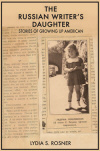The Russian Writer’s Daughter
Never judge a book by its title. The Russian Writer’s Daughter sounds like one of the far-too-many tragic family histories of life and creativity during the Soviet Union. And while Lydia Rosner is the daughter of Russian writer Abraham Sokolovsky (changed to Sokol upon immigrating to America in 1917), her accessible, thoughtful memoir is an American one, specifically a New York City one. She focuses on her own life and that of other Russians in the United States, at one point taking aim at another famous Russian writer’s daughter, Alexandra Tolstoy. Rosner and her father deride the charity Tolstoy founded and the White Russians (anti-Communist Russian immigrants) who take advantage of it as “fake.”
Never judge a book by its title. The Russian Writer’s Daughter sounds like one of the far-too-many tragic family histories of life and creativity during the Soviet Union. And while Lydia Rosner is the daughter of Russian writer Abraham Sokolovsky (changed to Sokol upon immigrating to America in 1917), her accessible, thoughtful memoir is an American one, specifically a New York City one. She focuses on her own life and that of other Russians in the United States, at one point taking aim at another famous Russian writer’s daughter, Alexandra Tolstoy. Rosner and her father deride the charity Tolstoy founded and the White Russians (anti-Communist Russian immigrants) who take advantage of it as “fake.”
Dr. Rosner is an expert on city and family life. As Professor Emeritus of Sociology at John Jay Community College, City University of New York, her research concentrates on the Russian migration of Brooklyn’s Brighton Beach neighborhood and the Russian Mafia. The only thing she shares in common with her subjects is being Russian. Her family valued education and success gained by honest hard work. There are relatives who are doctors and among those she encounters are Paul Robeson (who visited her summer camp) and pianist Eugene Istomin (one of her aunt’s boarders, incorrectly identified in the book as marrying cellist Pablo Casals’s daughter, not his widow).
In The Russian Writer’s Daughter, Dr. Rosner covers her Depression-era childhood through her young adulthood in the 1950s. It will not be lost on readers familiar with Manhattan that she lived in what is now the prime and prized real estate of the Upper West Side. Heartfelt appreciation is given to her own family’s boarders who “took up [her] mother’s curiosity,” thus “allowing her own space and Americanized world.”
As she does regarding being Russian, Dr. Rosner never sentimentalizes gentrification. Kindergarten was a life lesson:
At P.S. 186 I entered an English-speaking world of admirable teachers who had to contend with the new America. Children who spoke Russian, Polish, French, German and Hungarian. All new to this country. All running from a European world that was going up in flames. 1939. 1940. Only the Negro kids, as we knew them then were American. But they too were refugees in their own country at that time.
Additionally, by cleverly inserting a description of the “UP” and “DOWN” staircases in school buildings, Dr. Rosner pays tribute to Bel Kaufman, the granddaughter of a Russian-Yiddish writer (Shalom Aleichem) who taught in the New York City public school system and authored her own still-potent, funny memoir.
And unlike the Old Country before, during and after the Revolution, Russian Orthodox Christians and Jews co-existed peacefully. Rosner’s family even goes as far as participating in Easter celebrations because her parents sought and received an “affiliation” with their heritage.
Yet her recollections are not all idyllic. Her parents discuss a rock-throwing incident (a possible bias crime) in Yiddish, “the language of secrets,” as not to upset her or her brother Alex. Abraham declined an invitation from Stalin to return to the Soviet Union; returning would have meant the Gulag or worse. Then, fearing arrest during the height of the McCarthy era (“Now we’re all Communists,” he laments), her father destroys a family heirloom: the inside of a trunk lovingly covered with American maps:
The inside of the trunk was a colorful assemblage of United States maps, available free at every gas station. Papa had pasted them down in such a way that no writing showed. There was not a bump or lump everywhere. The muted reds and greens and yellows of states and countries, intersected by green roadways and blue rivers, created an elegant lining that looked just like the expensive luggage on display in the windows of better Fifth Avenue leather stores.
It is this tender story, along with the many others Dr. Rosner relates, that makes The Russian Writer’s Daughter valuable.





